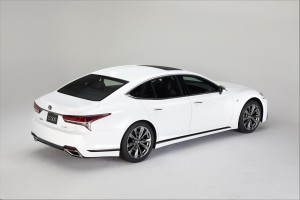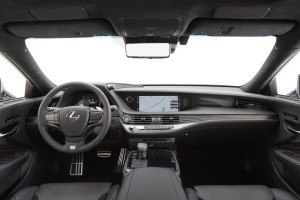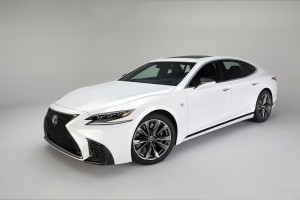The styling evolution of the Lexus line-up, specifically the Japanese brand’s LS flagship portfolio, continues with the debut of the all-new LS F Sport at the 2017 New York International Auto Show.
The new F Sport comes on the heels of the debut of the LS 500 in Detroit and the LS 500h in Geneva. The previous models offered the comfort, style and efficiency capable in the LS group, however, the F Sport is all about the speed and performance.
The all-new LS is based on an extended version of the brand’s premium global architecture for luxury vehicles, which is the stiffest that Lexus has ever developed. The result is enhanced handling, ride smoothness and cabin quietness. F Sport capitalizes on the platform’s responsiveness and agility to present the most engaging LS driving experience yet.
The F models, including GS F and RC F, are track-tuned maximum performance machines, according to the company. However, the F Sport versions feature “a more engaging driving spirit through carefully applied chassis tuning and enhancements, while still emphasizing exceptional comfort.”
On the new LS, the F Sport model will be available with gas and hybrid powertrains, and those choosing the RWD V6TT model will have the option of adding the F Sport Handling Package to bring a level of liveliness never before seen on the flagship sedan.
(To see more about thew new Lexus LS, Click Here.)

The new F Sport features two powertrains that equal or exceed that of the previous generation model.
Of course, the new F Sport continues the well-publicized mandate of no more staid designs, featuring a update to the car’s spindle grille. Developing the F Sport grille took computer-aided design operators some five months to achieve the desired texture and interaction with light.
Then 7,100 individual surfaces were tinkered with to achieve the desired look and texture (compared to 5,000 for the standard model’s grille). And when combined with the sporty enlarged side grille, it is functional as well, helping to maintain the vehicle’s cooling performance.
The special F Sport front grille, rocker panel, and trunk moldings accentuate the sedan’s rakish profile, while F Sport badging on fenders and exclusive 20-inch alloy wheels complete the exterior transformation. The new model also gets an exclusive color: Ultra White.
While making it look lean and mean is important, equally important is developing a powerplant that lives up to the hype. Lexus designed an all-new 3.5-liter V6 engine specifically for the new 2018 LS 500, using twin turbochargers developed through the company’s F1 technology. This new twin-turbo V6 offers V8-level performance – 415 horsepower and 442 lb-ft of torque – paired with the first-ever 10-speed automatic transmission in luxury sedan.
(Click Here to see details about Lexus hinting about the UX debut.)

The interior of the new LS 500 F Sport features all of the tech wizardry that one expects in the brand's flagship.
The engine yields a broad torque curve and in concert with the new transmission delivers instant acceleration and a constant buildup of torque toward the vehicle’s redline. The LS 500 runs 0-60 mph in 4.5 seconds (gas RWD). An electric wastegate is among the features that contribute to the engine’s rapid responses. The driver can tailor powertrain response and feel by choosing from Normal, Sport S or Sport S+ modes, and just enough of the exhaust note is heard to enhance the sporty feel.
However, the gas-only model isn’t the exclusive engine for the F Sport. The LS 500h F Sport uses a new Multi Stage Hybrid System combining a naturally aspirated Atkinson-cycle 3.5-liter V6 gasoline engine with two electric motor/generators and uses a compact, lightweight lithium-ion battery.
The V6 engine uses D-4S direct fuel injection, and lightweight valvetrain components, with Dual VVT-i ensuring ample torque across the engine speed range that puts out 354 hp propelling the hybrid from 0 to 60 in 5.2 seconds: the same as the previous-gen V8-powered model.
Fast is good. Fast with superior handling is great and the new F Sports feature the latest edition of the brand’s Vehicle Dynamics Integrated Management system implements cooperative control of all vehicle subsystems – braking, steering, powertrain, and suspension – to control basic longitudinal, lateral and vertical motion as well as yaw, roll and pitch.
(Lexus downsizes with new UX SUV concept. Click Here for the story.)
Optimal control of these motions helps to enable exceptional ride comfort, enhanced traction and safety and handling agility, and allows for enriched flat vehicle posture during cornering as well as a more comfortable and stable ride overall.

